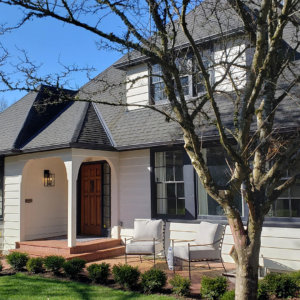ORIGINAL POST:
As we approached Portland’s record breaking heat wave in June, I was asked by Oregon.live writer Janet Eastman to contribute to an article titled “Fire smart landscaping doesn’t have to look like the desert.”
It definitely got me thinking that the need to protect our homes during wildfire season is growing more urgent, creating a new paradigm in sustainable landscape design.
Water Conservation vs. Fire-Smart Landscaping
For the past few decades the urgent need to conserve water has informed residential landscape design. Now, with climate change impacting us in immediate and direct ways like the wildfires of 2020 and the 2021 heat dome, when the Pacific Northwest suffered through three days over 100° temperatures in a row, it’s time to think about fire smart landscaping.
Designing for water smart and fire smart landscaping in a single landscape presents new opportunities and challenges, both in plant choices and in design styles.
When it comes to plants, using deciduous trees and plants with low sap or resin while avoiding high resin conifers may become the new norm. There are many good sources of information on fire-resistant plants, but one of my favorites is the forty-four page “Fire-Resistant Plants for Home Landscapes,” published by the Oregon State University Extension Service.
Designing a Fire-Smart Landscape Landscape for the Urban Yard
From a design perspective, we can integrate fire smart landscaping principles into urban landscapes by:
- minimizing foundation plantings
- avoiding tall plants near the house and keeping tree branches away from the roof
- planting the perimeter of the yard in clusters
- breaking up borders with stone, pavers or grass
- integrating low resin native plants into ornamental beds
- replacing mulch with succulent groundcovers
- maintaining a healthy and well-watered lawn
Designing a Fire-Smart Landscape Landscape for Large Lots and Rural Homes
Fire smart landscaping for larger homes and rural homes that are higher risk requires a different way of thinking about the landscape. Oregon.gov’s Urban Interface Fire Protection Act offers a Fire Protection Tip infographic that includes the following recommendations:
- divide your property into fire zones
- create defensible space (see Oregon.gov’s defensible space self-certification)
- keep firewood and lumber away from the house and wooded areas
- ensure good access for emergency vehicles, keep space under wood decks and stairways clean and includes
- remove dead branches and flammable material from the roof and gutters
- avoid fuel ladders (dead or live vegetation that allows fire to climb into the tree canopy)
Do Your Research & Hire a Professional Landscape Designer
The best advice I can give to a homeowner is to learn about fire-smart landscaping, assess your risk and, if you need help, hire a professional landscape designer.
- Keep foundation planting low to the ground.
- Opt for patios instead of plants in front of your home.
- Break up the landscape with stone swales like this one.




